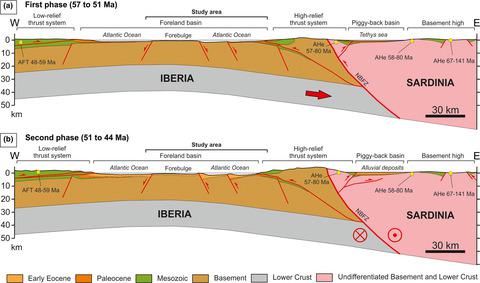当前位置:
X-MOL 学术
›
Basin Res.
›
论文详情
Our official English website, www.x-mol.net, welcomes your feedback! (Note: you will need to create a separate account there.)
Tectono‐sedimentary evolution of transverse extensional faults in a foreland basin: response to changes of tectonic plate processes
Basin Research ( IF 3.2 ) Pub Date : 2020-02-11 , DOI: 10.1111/bre.12434 Emilio Carrillo 1, 2 , Ander Guinea 3 , Albert Casas 1 , Lluis Rivero 1 , Nicole Cox 3 , Yaniel Misael Vázquez‐Taset 2, 4
Basin Research ( IF 3.2 ) Pub Date : 2020-02-11 , DOI: 10.1111/bre.12434 Emilio Carrillo 1, 2 , Ander Guinea 3 , Albert Casas 1 , Lluis Rivero 1 , Nicole Cox 3 , Yaniel Misael Vázquez‐Taset 2, 4
Affiliation

|
[Abstract Late Paleocene to Middle Eocene strata in the easternmost part of the Southern Pyrenees, up to 4 km thick, provide information on tectono‐sedimentary evolution of faults transversal to the Pyrenean chain. To know how changes in tectonic plate processes control the structural evolution of transverse faults and the synchronous thickness and lithological distribution of sedimentary strata in a foreland basin, field observations, interpretation of 2D seismic lines tied to lithostratigraphic data of exploration wells and gravity modelling constrains were carried out. This resulted in the following two tectono‐sedimentary phases in a foreland basin: first phase, dominated by transverse extensional faulting, synchronous with deposition of marine carbonates (ca. 57 to 51 Ma); and second phase, characterized by transverse contractional faulting, coeval to accumulation of marine and transitional siliciclastics (51 to 44 Ma). During the first phase, Iberia and Adria were moving to the east and west respectively. Therefore, lithospheric flexure in the easternmost part of the Iberian plate was developed due to that Sardinia was over‐thrusting Iberia. Consequently, activation of E‐dipping normal faults was generated giving rise to thick‐deep and thin‐shallow carbonate platform deposits across the hanging walls and footwalls of the transverse structures. During the second phase, a shearing interaction between Iberia and Sardinia prevailed re‐activating the transverse faults as contractional structures generating thin‐shelf and thick‐submarine fan deposits across the hanging walls and footwalls of the transverse structures. In the transition between the first and second phases, evaporitic conditions dominated in the basin suggesting a tectonic control on basin marine restriction. The results of our study demonstrate how thickness and lithology distribution, controlled by transverse faulting in a compressional regimen, are influenced by phases related to processes affecting motions and interactions between tectonic plates and continental blocks., Crustal‐scale cross‐sections across the South‐eastern Pyrenees showing the interaction evolution between Iberia and Sardinia from Late Paleocene (57 Ma) to Middle Eocene (44 Ma). This evolution exerted a control on structural evolution of transverse faults and synchronous thickness and lithology distribution. ]
中文翻译:

前陆盆地横向伸展断层的构造沉积演化:对构造板块过程变化的响应
[摘要:南比利牛斯山脉最东端的晚古新世至中始新世地层,厚达 4 公里,提供了关于比利牛斯山脉横向断层构造沉积演化的信息。为了了解构造板块过程的变化如何控制前陆盆地横向断层的构造演化以及沉积地层的同步厚度和岩性分布,现场观测、与勘探井岩石地层数据相关的二维地震线的解释和重力建模约束是执行。这导致前陆盆地出现以下两个构造沉积阶段:第一阶段,以横向伸展断层为主,与海相碳酸盐岩沉积同步(约 57 至 51 Ma);第二阶段,以横向收缩断层为特征,与海洋和过渡硅质碎屑的堆积同时期(51 至 44 Ma)。在第一阶段,伊比利亚和亚德里亚分别向东和向西移动。因此,伊比利亚板块最东端的岩石圈弯曲是由于撒丁岛过度推挤伊比利亚而形成的。因此,E 倾正断层的激活产生了横跨横向构造的上盘和下盘的厚-深和薄-浅碳酸盐台地沉积物。在第二阶段,伊比利亚和撒丁岛之间的剪切相互作用盛行,重新激活了横向断层,因为收缩结构在横向结构的上盘和下盘上产生薄陆架和厚海底扇沉积物。在第一阶段和第二阶段之间的过渡中,盆地中的蒸发条件占主导地位,表明盆地海洋限制受到构造控制。我们的研究结果表明,受挤压方式中横向断层控制的厚度和岩性分布如何受到与影响构造板块和大陆块之间的运动和相互作用的过程相关的相的影响。东比利牛斯山脉显示了从晚古新世(57 Ma)到中始新世(44 Ma)伊比利亚和撒丁岛之间的相互作用演化。这种演化控制了横向断层的构造演化和同步厚度和岩性分布。] 受挤压方式中横向断层控制,受与影响构造板块和大陆块之间的运动和相互作用的过程相关的阶段的影响。,东南比利牛斯山脉的地壳尺度横截面显示了伊比利亚和撒丁岛之间从晚期的相互作用演化古新世 (57 Ma) 至中始新世 (44 Ma)。这种演化控制了横向断层的构造演化和同步厚度和岩性分布。] 受挤压方式中横向断层控制,受与影响构造板块和大陆块之间的运动和相互作用的过程相关的阶段的影响。,东南比利牛斯山脉的地壳尺度横截面显示了伊比利亚和撒丁岛之间从晚期的相互作用演化古新世 (57 Ma) 至中始新世 (44 Ma)。这种演化控制了横向断层的构造演化和同步厚度和岩性分布。] 东南比利牛斯山脉的地壳尺度横截面显示了从晚古新世(57 Ma)到中始新世(44 Ma)伊比利亚和撒丁岛之间的相互作用演化。这种演化控制了横向断层的构造演化和同步厚度和岩性分布。] 东南比利牛斯山脉的地壳尺度横截面显示了从晚古新世(57 Ma)到中始新世(44 Ma)伊比利亚和撒丁岛之间的相互作用演化。这种演化控制了横向断层的构造演化和同步厚度和岩性分布。]
更新日期:2020-02-11
中文翻译:

前陆盆地横向伸展断层的构造沉积演化:对构造板块过程变化的响应
[摘要:南比利牛斯山脉最东端的晚古新世至中始新世地层,厚达 4 公里,提供了关于比利牛斯山脉横向断层构造沉积演化的信息。为了了解构造板块过程的变化如何控制前陆盆地横向断层的构造演化以及沉积地层的同步厚度和岩性分布,现场观测、与勘探井岩石地层数据相关的二维地震线的解释和重力建模约束是执行。这导致前陆盆地出现以下两个构造沉积阶段:第一阶段,以横向伸展断层为主,与海相碳酸盐岩沉积同步(约 57 至 51 Ma);第二阶段,以横向收缩断层为特征,与海洋和过渡硅质碎屑的堆积同时期(51 至 44 Ma)。在第一阶段,伊比利亚和亚德里亚分别向东和向西移动。因此,伊比利亚板块最东端的岩石圈弯曲是由于撒丁岛过度推挤伊比利亚而形成的。因此,E 倾正断层的激活产生了横跨横向构造的上盘和下盘的厚-深和薄-浅碳酸盐台地沉积物。在第二阶段,伊比利亚和撒丁岛之间的剪切相互作用盛行,重新激活了横向断层,因为收缩结构在横向结构的上盘和下盘上产生薄陆架和厚海底扇沉积物。在第一阶段和第二阶段之间的过渡中,盆地中的蒸发条件占主导地位,表明盆地海洋限制受到构造控制。我们的研究结果表明,受挤压方式中横向断层控制的厚度和岩性分布如何受到与影响构造板块和大陆块之间的运动和相互作用的过程相关的相的影响。东比利牛斯山脉显示了从晚古新世(57 Ma)到中始新世(44 Ma)伊比利亚和撒丁岛之间的相互作用演化。这种演化控制了横向断层的构造演化和同步厚度和岩性分布。] 受挤压方式中横向断层控制,受与影响构造板块和大陆块之间的运动和相互作用的过程相关的阶段的影响。,东南比利牛斯山脉的地壳尺度横截面显示了伊比利亚和撒丁岛之间从晚期的相互作用演化古新世 (57 Ma) 至中始新世 (44 Ma)。这种演化控制了横向断层的构造演化和同步厚度和岩性分布。] 受挤压方式中横向断层控制,受与影响构造板块和大陆块之间的运动和相互作用的过程相关的阶段的影响。,东南比利牛斯山脉的地壳尺度横截面显示了伊比利亚和撒丁岛之间从晚期的相互作用演化古新世 (57 Ma) 至中始新世 (44 Ma)。这种演化控制了横向断层的构造演化和同步厚度和岩性分布。] 东南比利牛斯山脉的地壳尺度横截面显示了从晚古新世(57 Ma)到中始新世(44 Ma)伊比利亚和撒丁岛之间的相互作用演化。这种演化控制了横向断层的构造演化和同步厚度和岩性分布。] 东南比利牛斯山脉的地壳尺度横截面显示了从晚古新世(57 Ma)到中始新世(44 Ma)伊比利亚和撒丁岛之间的相互作用演化。这种演化控制了横向断层的构造演化和同步厚度和岩性分布。]


























 京公网安备 11010802027423号
京公网安备 11010802027423号